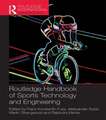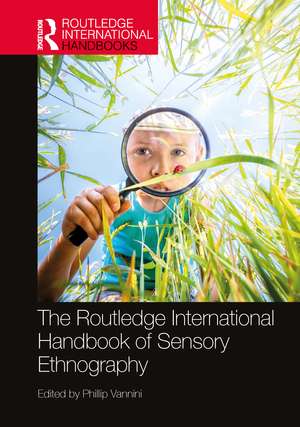The Routledge International Handbook of Sensory Ethnography: Routledge International Handbooks
Editat de Phillip Vanninien Limba Engleză Hardback – 28 noi 2023
Sensory ethnography is a transdisciplinary research methodology focused on the significance of all the senses in perceiving, creating, and conveying meaning. Drawing from a wide variety of strategies that involve the senses as a means of inquiry, objects of study, and forms of expression, sensory ethnography has played a fundamental role in the contemporary evolution of ethnography writ large as a reflexive, embodied, situated, and multimodal form of scholarship. The handbook dwells on subjects like the genealogy of sensory ethnography, the implications of race in ethnographic inquiry, opening up ethnographic practice to simulate the future, using participatory sensory ethnography for disability studies, the untapped potential of digital touch, and much more.
This is the most definitive reference text available on the market and is intended for advanced undergraduates, graduate students, and researchers in anthropology, sociology, and the social sciences, and will serve as a state-of-the-art resource for sensory ethnographers worldwide.
Din seria Routledge International Handbooks
-
 Preț: 371.78 lei
Preț: 371.78 lei -
 Preț: 375.50 lei
Preț: 375.50 lei -
 Preț: 362.20 lei
Preț: 362.20 lei -
 Preț: 352.09 lei
Preț: 352.09 lei - 9%
 Preț: 1487.73 lei
Preț: 1487.73 lei - 5%
 Preț: 317.32 lei
Preț: 317.32 lei -
 Preț: 372.05 lei
Preț: 372.05 lei -
 Preț: 361.20 lei
Preț: 361.20 lei -
 Preț: 390.14 lei
Preț: 390.14 lei -
 Preț: 311.91 lei
Preț: 311.91 lei - 9%
 Preț: 1488.70 lei
Preț: 1488.70 lei -
 Preț: 390.23 lei
Preț: 390.23 lei -
 Preț: 347.75 lei
Preț: 347.75 lei -
 Preț: 347.75 lei
Preț: 347.75 lei - 9%
 Preț: 1490.13 lei
Preț: 1490.13 lei -
 Preț: 356.23 lei
Preț: 356.23 lei -
 Preț: 348.29 lei
Preț: 348.29 lei - 5%
 Preț: 328.13 lei
Preț: 328.13 lei -
 Preț: 394.25 lei
Preț: 394.25 lei - 8%
 Preț: 392.90 lei
Preț: 392.90 lei - 8%
 Preț: 422.42 lei
Preț: 422.42 lei -
 Preț: 357.23 lei
Preț: 357.23 lei - 8%
 Preț: 421.97 lei
Preț: 421.97 lei - 5%
 Preț: 452.17 lei
Preț: 452.17 lei - 9%
 Preț: 1665.72 lei
Preț: 1665.72 lei - 9%
 Preț: 1651.64 lei
Preț: 1651.64 lei -
 Preț: 350.21 lei
Preț: 350.21 lei -
 Preț: 381.91 lei
Preț: 381.91 lei -
 Preț: 345.64 lei
Preț: 345.64 lei -
 Preț: 347.75 lei
Preț: 347.75 lei - 20%
 Preț: 1401.04 lei
Preț: 1401.04 lei -
 Preț: 342.77 lei
Preț: 342.77 lei -
 Preț: 346.78 lei
Preț: 346.78 lei -
 Preț: 345.17 lei
Preț: 345.17 lei -
 Preț: 353.89 lei
Preț: 353.89 lei -
 Preț: 1058.63 lei
Preț: 1058.63 lei -
 Preț: 348.06 lei
Preț: 348.06 lei - 5%
 Preț: 337.34 lei
Preț: 337.34 lei -
 Preț: 365.90 lei
Preț: 365.90 lei - 9%
 Preț: 1528.89 lei
Preț: 1528.89 lei -
 Preț: 346.12 lei
Preț: 346.12 lei -
 Preț: 392.49 lei
Preț: 392.49 lei - 9%
 Preț: 1454.53 lei
Preț: 1454.53 lei - 9%
 Preț: 1492.85 lei
Preț: 1492.85 lei - 5%
 Preț: 326.87 lei
Preț: 326.87 lei -
 Preț: 361.75 lei
Preț: 361.75 lei - 9%
 Preț: 1349.84 lei
Preț: 1349.84 lei - 19%
 Preț: 422.81 lei
Preț: 422.81 lei - 8%
 Preț: 385.56 lei
Preț: 385.56 lei
Preț: 1599.79 lei
Preț vechi: 1758.02 lei
-9% Nou
Puncte Express: 2400
Preț estimativ în valută:
306.13€ • 327.35$ • 255.24£
306.13€ • 327.35$ • 255.24£
Carte disponibilă
Livrare economică 27 martie-10 aprilie
Livrare express 13-19 martie pentru 79.12 lei
Preluare comenzi: 021 569.72.76
Specificații
ISBN-13: 9781032328737
ISBN-10: 1032328738
Pagini: 498
Ilustrații: 9 Halftones, color; 41 Halftones, black and white; 9 Illustrations, color; 41 Illustrations, black and white
Dimensiuni: 174 x 246 x 31 mm
Greutate: 1.84 kg
Ediția:1
Editura: Taylor & Francis
Colecția Routledge
Seria Routledge International Handbooks
Locul publicării:Oxford, United Kingdom
ISBN-10: 1032328738
Pagini: 498
Ilustrații: 9 Halftones, color; 41 Halftones, black and white; 9 Illustrations, color; 41 Illustrations, black and white
Dimensiuni: 174 x 246 x 31 mm
Greutate: 1.84 kg
Ediția:1
Editura: Taylor & Francis
Colecția Routledge
Seria Routledge International Handbooks
Locul publicării:Oxford, United Kingdom
Public țintă
Academic, Postgraduate, Professional, and Undergraduate AdvancedRecenzii
"This is a pivotal volume that invites readers to immerse themselves in the bountiful landscape of sensory ethnography before offering a host of possibilities for its future development as a unique, and crucial, way of knowing about the lifeworlds we collectively inhabit. All ethnographers and qualitative researchers will gain immensely from dwelling within the pages of this beautifully crafted and thought-provoking book".
-Andrew C. Sparkes, Leeds Beckett University, UK
"Readers should be warned that an avalanche of sensorial vibrations will travel through their veins as they dive into this stellar compilation, which places in conversation the 'giants' of sensory ethnography. Our contemporary world starves for caring and meaningful relations. Sensory ethnography responds to this need, and this volume tells us why".
-Alexandrine Boudreault-Fournier, University of Victoria, Canada
"A vital collection of works that will be an instant classic. Under Vannini’s editorship the handbook achieves remarkable coverage and depth. Not only is his introduction a masterful orientation to the essays inside but it establishes clearly and powerfully that this is an essential resource for anyone interested in ethnography".
-Craig Campbell, University of Texas, Austin, USA
-Andrew C. Sparkes, Leeds Beckett University, UK
"Readers should be warned that an avalanche of sensorial vibrations will travel through their veins as they dive into this stellar compilation, which places in conversation the 'giants' of sensory ethnography. Our contemporary world starves for caring and meaningful relations. Sensory ethnography responds to this need, and this volume tells us why".
-Alexandrine Boudreault-Fournier, University of Victoria, Canada
"A vital collection of works that will be an instant classic. Under Vannini’s editorship the handbook achieves remarkable coverage and depth. Not only is his introduction a masterful orientation to the essays inside but it establishes clearly and powerfully that this is an essential resource for anyone interested in ethnography".
-Craig Campbell, University of Texas, Austin, USA
Notă biografică
Phillip Vannini is Professor in the School of Communication and Culture at Royal Roads University (Canada). He is the author/editor of 20 books, and from 2010 to 2020 he was the series editor for Routledge’s Innovative Ethnographies Series. Phillip’s documentary films have been distributed worldwide through television, in movie theaters, as well as through SVOD platforms such as Amazon Prime, iTunes, Google Play, Kanopy, and more.
Cuprins
1. Introduction: sensory ethnography Phillip Vannini PART 1: The past, present, and future of sensory ethnography 2. Re-sensing the sensory: evoking the senses in a troubled world Paul Stoller 3. Origin and development of sensory ethnography David Howes 4. Ethnography and the sounds of everyday life Michael Bull 5. Getting a grip on new objects, technologies, and novel sensations Mark Paterson 6. Sensory futures ethnography Sarah Pink PART 2: The practice of sensory ethnography 7. Awareness, focus and nuance: reflexivity and reflective embodiment in sensory ethnography John Hockey and Jacquelyn Allen-Collinson 8. Sensing the city: multi-sensory participant observation and urban ethnography Cristina Moretti 9. Interviewing on atmospheres: sensory explorations of the mundaneness of urban space Mikkel Bille 10. Sensing freedom through festival Culture: a sensory autoethnographic perspective Réa de Matas 11. Disability and methods for better understanding the sense and sensibilities of everyday mobilities Gordon Waitt and Theresa Harada 12. Bringing sensory ethnography to digital touch: sensory Interviews, objects, and tours Carey Jewitt and Ned Barker 13. Signals, access, and sensory frictions: conducting research on cochlear implantation in India Michele Friedner 14. Writing senses Simon Gottschalk 15. Sensuous pedagogies: observations and reflections on teaching sensual ethnography Dennis Waskul PART 3: Affective and atmospheric sensory ethnography 16. Elemental Kathleen Stewart 17. Sensuous geographies of “foot mobilities’”: comparing running with walking Jonas Larsen 18. The “Full English:” British Muslims, British food and a community project Alex Rhys-Taylor 19. Exploring sensory design through sensory ethnography Erin Lynch 20. Feeling helium Marina Peterson PART 4: More-than-human sensory ethnography 21. Towards a multisensorial engagement with other animals: cases from Mongolia and Pakistan Natasha Fijn and Muhammad Kavesh 22. White clouds in the blue sky Kate Hennessy, Trudi Smith, and Steve DiPaola 23. Sensory ethnographers’ gaze in sport fishing Vesa Markuksela 24. Sensory ethnography as a more-than-human approach to urban inequalities Elisa Fiore 25. Resonances Chris Wright 26. Sensory engagements with lively data: understanding the more-than-human world with and through timber sculptures Deborah Lupton, Ash Watson and Vaughan Wozniak-O’Connor PART 5: Performative and more-than-representational sensory ethnography 27. Defamiliarizing the sensory Tim Edensor 28. Sensuous ethnography or sensory ethnography? Phillip Vannini 29. Sensorial agoraphobia: lecture halls, fluorescent lights, and neurology Michelle Charette and Denielle Elliott 30. Staging unmemorials, being haunted: the grievability of Japanese sex workers in the transpacific underground Ayaka Yoshimizu 31. Sensing scenes: doing sensory ethnography in queer social spaces Kerryn Drysdale 32. The classroom and the field: from engaged pedagogy to sensory ethnography Sander Holsgens PART 6: Multi-modal sensory ethnography 33. Archiving the senses: an ethnography by design Rupert Cox 34. Applied sensory ethnography: multimodal installations and sonic experiments in equitable urban development Beth Uzwiak 35. Reframing deafness: vision as fieldwork method and documentary art Andrew Irving 36. Camera-led research and the photographic image: river life in the shadow of a dam Craig Campbell 37. Drawing as a form of bodily engagement beyond vision Alexandrine Boudreault-Fournier 38. Framing the voice in sensory ethnography Kathy Kasic Epilogue Anna Harris
Descriere
This volume reviews and expands the field and scope of sensory ethnography by fostering new links amongst sensory, affective, more-than-human, non-representational, and multimodal sensory research traditions and composition styles.
